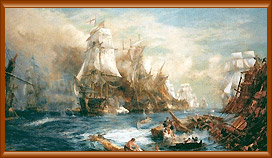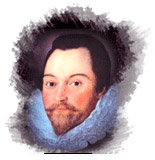The Battle of Calais
It was a part of Spanish Armada's campaign against England. Spanish Armada-fleet in Spanish- sailed toward England to return her as a catholic country and retaliate English pirates' buccaneering. Though Spaniards had outstanding land forces, they failed to embark them and anchor any port of England neither Scotland. English defeated Spaniard at the English Channel off Gravelines near by Calais. After this battle, Spain gradually lost her dominance at sea and it gave a chance for England to be a new power at sea .
Historical Background
The Protestant Reformation
As time goes by, Protestantism was welcomed in most European countries and the conflicts sparked between two religions was drifted into war. England broke with Rome during reign of Henry VIII.
 The Battle of Calais
The Battle of Calais
He closed all Roman Catholic abbeys and monastery and seized their property and announced that he's the head of English Church. He conducted this religious rebellion against Rome, because the Rome disapproved his divorce.
This religious conflict reached climax in France on 24th August, 1572. Hundreds of French protestants, Huguenots were butchered by Catholics at the wedding of Princess Marguerite. Catholic dominant countries, Spain and France hailed this massacre. He dispatched the army to the Netherlands which was under control of Spain in order to suppress Protestantism. This sparked the movement of independence of the Netherlands. In 1566, Protestant party in the Netherlands rose in rebellion on the behalf of England. Ironically, his suppression policy became the one of reasons of defeat at the Battle of Gravelines. Dutch protestants interfered the embarkation of Spanish land forces.
Conflict between England and Spain
Beside, she followed her father's religious policy and supported the Protestant dominant countries in the continent, the Netherlands for instance. She gave aides for Protestants in the Netherlands to protect this area from Spain.
 Drake
Drake
The distance between England and this land wasn't so far, thus Spaniards in here was huge threat to the England. Spaniards had ships to carry strong land forces from this area to the England. For these reasons, Elizabeth always had contacts with Dutch.
The presence of Elizabeth's pirates at sea was one of the biggest obstacles to Spain. Philip regarded English ships since July, 1580 and accused Drake due to his piracies in the West Indies and Atlantic Ocean. He occasionally sailed to the West Indies and sacked the Spanish colonies or Spanish ships on their return way to their mother country. However, Elizabeth gave him the honor of knighthood. In the mean time, England dispatched army to the Netherlands and joined the independence war against Spanish rule in 1585.
Philip's invasion plan of England
Spanish invasion plan was settled by veteran sailor, Marquess of Santa Cruze at first place. He was supposed to conquer Ireland and, then would march to the England. But this plan was scattered after his sudden death. Duke of Medina succeeded him. He was great soldier but, inexperienced at sea battles. It was one of reasons why Spanish lost this campaign. Philip's plan was focused on combining his fleet with Parma's land forces off Spanish Netherlands. He and his councilors were convinced that battle-trained Spaniards would defeat English army if they land on England.
England's preparation
The progress of Spanish plans, the structure of fleet and their commanders' name were updated by English spies in Spain. According to the letter was sent to the English government, 130 ships including 4 galleases and 4 galleys were prepared for the invasion, while Don Alonso di Lieva was appointed as the general in charge of the Spanish land forces. A Spanish ship was sent to Calais to set up the plan with Parma's army before fleet departed. This letter was based on a captain's letter of Italian ship, was being worked for the Spanish government.
The battle
Fleet and commanders
| Winner : English fleet | Spaniard fleet | |
|---|---|---|
| Commanders | Lord Admiral : Charles, Lord Howard of Effingham Vice Admiral : Sir Francis Drake Rear Admiral : Sir John Hawkins Sir Martin Frobisher |
Commander-in-chief : Duke of Medina Sidonia General(Cammander of land forces) : Don Alonso di Lieva |
| Crews | Sailors and seaman : 15,000 | Total : 28,000 Soldiers : 20,000 Sailors and others : 8,000 |
| Warships | Total : 197 Fighting ships : 75(new built galleons : 20) |
Total : 130 Fighting ships : 65(Galleases : 4. Galleys : 4) Hospital ships : 2 |
Spanish sail to the England
On 6-7th August, Armada anchored near by Calais where Parma's army would join them. It wasn't easy to anchor in here due to their ships' size, they waited Parma's transport ships, pontoons from there. English fleet also anchored beside Spaniard fleet. Medina Sidonia already sent his messenger to Parma before his fleet reach Calais, but Parma's army were never shown. At that time, Parma thought this invasion would be failed, therefore he sent his army into the inland according to newly released Spanish research.
At Battle day
Result
On their way to Spain, Spaniards were suffered from heavy storms and starving. Starving Spaniards landed on Ireland, but they were killed by the army of Elizabeth. The Medina Sidonia could reach Santander on September 13 after he lost a half of his fleet and hundreds of sailors.
Aftermath
Reference
Films
- Elizabeth : The Golden Age(2007), Universal Pictures
Books
- 50 Military leaders who changed the world, William Weir(2007)
- The Defeat of the Spanish Armada, Garrett Mattingly
Websites
- British Library : http://www.bl.uk/learning/histcitizen/uk/armada/source2/channel.html
- National Archives : http://www.nationalarchives.gov.uk/nelson/gallery7/trafalgar.htm
- BBC History : http://www.bbc.co.uk/history/british/tudors/adams_armada_01.shtml